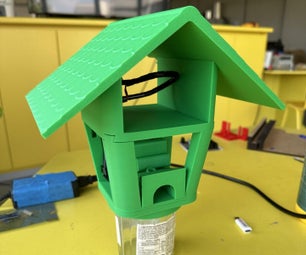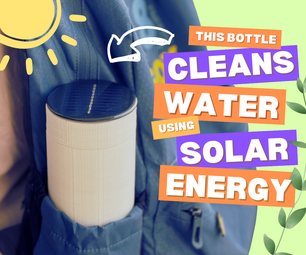Introduction: DIY 2k(2560x1440) LED Beam Projector
This instruction explains how to make a DIY 2k resolution (2560x1440) beam projector.
The original posts are in my blogger (link1 & link2) in poor English, and in my Korean blog.
Many necessary stuffs were from China, and I am lucky to get those stuffs easily here in Korea.
You can use "aliexpress.com" to get most of parts. In my case, I used "taobao.com" as it is usually cheaper than aliexpress.com.
What you need
- LCD and LCD HDMI board : 5.98 inch, 2560x1440 resolution from topfoison.com (around 200 USD) or you can use other small 2k LCDs if there is a proper board. You can ask them to separate a backlight unit (BLU). We do not need the BLU as we will use LED light source.
- Case (Housing) : black arcryl with lazer cut, and one side is sanded beforehand (you can use spray), for someone who wanna save his time, I attach AutoCad files that I made. Some explainations are written in Koreans in the files, and it is about tap-screw sign. (around 100 USD in Korea including lazer cut & tapping screw holes)
- Fresnel LENS : focal lenth 120 and 185, F120 is placed near LED and F182 is placed near the projection lens (you can use local stores, or you can find several sellers selling fresnel lens in aliexpress.com) this costs less than 50USD
- Projection LENS : F190 (F200 is also ok) (you can find this in aliexpress.com), this also costs less than 50USD.
- LED light
- Conventional way : 150 watt LED from taobao.com with heatpipe. Alternative is 128watt in aliexpress.com (around 57USD), you should find a proper LED driver. I do not recommend this conventional cheap version. It leads to blurry image at edges and corner points.
- Fancy way : Nobody tried this LED to make DIY projector as far as I know. This will solve every focusing issues that happen in DIY projectors. Use LED in medical field. I found "CBT-140" from Luminus. One seller in aliexpress.com sells this LED and corresponding driver in 185USD. little bit expensive, but worthwhile. Here is the link, and it runs at 100 watt. Not that bright, so you need a dark room.
- Condenser Lens : square-shaped lens from taobao.com, also available in aliexpress.com (around 25USD), or you can use conventional round-shaped lens. The square version shows better brigtness, but the left and right edges become little bit yellow.
- ETC : several cooling fans, usb power line, proper wires, your hands.
Why did I make it?
- Fun
- I can own 2k resolution projector at cheap price (less than 1000USD). You'd better to search the prices of commercial 2k projectors.
- Initial step to make 4k projector: finally I want to have a 4k projector, but the commercial 4k projectors are way too expensive.
Limitations
- If you gonna use LED light in conventional way, you will end up with blurry images. You never get the perfect focus. However, if follow the fancy way, you will get perfect focus, and you can distinguish every 2k pixels at the same time.
- Brightness is way too poor compared to commercial products as we use the small LCD that is used in cell phones. This kind of LCDs has low transparency. At night, w/o ambient lights, it will move your heart, but you cannot see nothing in day time. Anyway, if you have a dark room, this is perfect for you for gaming and movies.
Attachments
Step 1: Check the LCD & Design the Housing
Before to assemble the case, check the LCD first.
You will get the HDMI and LCD.
For convenience, I ordered extension FPC cable (around 10 cm) with simple extension board.
As I ordered LCD to be separated from the BLU, I must have pressed and held the backlight connector to check the LCD.
After checking the LCD, design your case.
You may skip this step if you are willing to use my AutoCAD files.
Or, modify the files depending on your stuffs.
Step 2: Make the Case & Fresnel Lens Holder
1. Make the whole case
Prepare the arcryl parts following the AutoCAD files.
Assemble the case using small joint parts, and glue them permanently by using "chloroform".
Do not apply chloroform on the top cover, the top cover will be held by headless screws.
2. Make "Fresnel lens holder"
The Fresnel lens will be placed inside of the case.
First, the fresnel lens is held by "fresnel lens holder", and then the fresnel lens holder will be placed in a holder for LCD and the fresnel lens holder.
When making the fresnel lens holder, the shinny lines by the lazer cut should be sanded to prevent a diffused lightreflection which will lead to a poor image quality.
Or you can simply attach micro-sanded paper on the shinny lines.
Step 3: Make LCD Holder
In my opinion, this step is the most important step.
The little LCD has very small inactive area (bezel), so it is difficult to hold the LCD properly while preventing light leakage.
After measuring the dimensions of the LCD "exactly", I designed the LCD holder which can prevent light leakage and guarantee the image quality.
If you make the LCD holder roughly, you will end up with ugly light leaked image as shown in the picture. (I had failed once before to make this version.)
Following my drawing, you will find three parts to construct the LCD holder.
Two parts are to hold the LCD permanently, while one part is to hold the LCD temporarily.
You will find how to hold the LCD by following the uploaded pictures.
Be careful not to touch the LCD with your raw hands, your fingerprint will make you cry. Please use nitryl gloves when dealing with the LCD.
Step 4: Attach LED on the Heatpipe and Make LED Holder
Whether you choose the conventional LED or the fancy LED (CBT-140), the way to attach the LED on the heatpipe is same. (CBT-140 is adopted recently, so the pictures are mixed up with the conventional LED version.)
Basically you need to tap M3 screws onto the heatpipe to hold the LED. (or a seller provides prepared screw holes).
Place the thermal grease on the back side of LED, and attach the LED with bolts.
And then, hold the condenser lens properly in front of the LED. Many sellers provide proper tools to hold the condenser lens.
Step 5: Wiring and Install Cooling Fans
I installed fan controller, but you can skip this if you do not wish to control fan speed.
The basic wiring is as follows:
- AC power line is connected to power supply and USB power supply (in parallel).
- The power supply converts AC into DC.
- The power supply is connected to LED and cooling fans. Depending on your design, you may use two power supply; one for fans and one for LED.
- The USB power supply will be connected to the HDMI board.
- Install switches to control the powers. In my case, I installed two switches, so one turns on/off the LED and the LCD, while the other turns on/off the cooling fans. Therefore, I can overcool the inside of the case after the LED is off.
I installed many cooling fans to cool down the LCD.
The LCD is near to the LED (around 110~130 mm). If you don't cool the LCD enough, you will see black spots on the LCD. The LED emitts a lot of heat energy.
I had tested with "no" cooling fans for the LCD, and the LCD was dead after many black spots.
Please install small (cute) blower fans and normal fans to cool down the LCD.
In the uploaded pictures, you will see the air circulation strategy.
Of course, you may have better air circulation idea. Please share the knowledge if you have any.
Step 6: Test the LED and Optics Arrangement
Once the wiring is done, then test the LED.
With the proper spacing between the LED and the back fresnel lens (F120), the LED light will cover the whole active area of the LCD.
When placing the fresnel lens, both groove sides of fresnel lens must face to the LCD.
When you make a DIY projector at the first time, you are prone to make mistakes at this step.
You may be curious why I chose F120/F185 fresnel lens with F190 projection lens.
The answer is that the optics in DIY is not perfect, and there are well-working combinations which have been updated in DIY projector groups.
In short, when we are using 6 inch LCD, the current lens combination works fine. Or, a combination for longer throwing distance will also work fine. (for example, F120/F220 fresnels with F230 projection lens also works fine)
Obviously, a short throwing distance will give you a large image size, and my combination has the shortest throwing distance, yet working fine. (I may be wrong, but I'd tested with many combinations)
With the given lens combination with CBT-140, you can distinguish every 2k pixels at the same time. The focusing capability is even with or better than commercial products.
Anyway, we need a rule of thumb to adjust the lens spacing.
As the optics is not perfect, we need to adjust the lens spacing manually.
It depends on person by person, but there are several rough rules.
- The spacing between LCD and the fresnel lens : 15~20 mm, if too short, LCD will be burned, too far, the image will be blury.
- The spacing between the back fresnel lens (F120) and the LED : some people says 90% of the focal length of the fresnel lens is good, some people says no. Adjust from the +/- 10% of the focal length of the back fresnel lens, and find the best image quality. It depends on your taste.
- The spacing between the projection lens (backside of triplet) and the front fresnel lens (F185) : around the focal length of the projection lens. In my case, it is around 190 mm. You can adjust the focus by moving the projection lens forward or backward.
Good news is that you have enough margins once you use the LED with a small light emitting area.
So please, do not go for the cheap LED arrays, just go for CBT-140. CBT-140 has the smallest light emitting area in available markets as far as I know.
Step 7: Enjoy
Done!
Clean the room, and enjoy your projector.
There are not many 2k sources.. but you can enjoy 2k trailers in youtube at least haha.
My next plan is to make 4k projector with budget less than 1200 USD.
If I make it, I will share with you.
By the way, I do not use this 2k projector at this moment. (Currently, I am using my another DIY FHD projector in my room)
This 2k projector is used to test several things for my future 4k projector haha.. I feel sorry to my projector.
Anyway, I hope this would be helpful to someone who wants to build his own projector.
See you!











